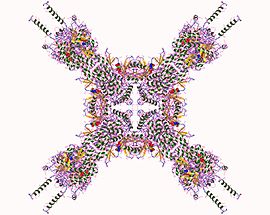1-phosphatidylinositol 4-kinase
| 1-phosphatidylinositol 4-kinase | |||||||||
|---|---|---|---|---|---|---|---|---|---|
 Phosphatidylinositol 4-kinase homo16mer, Human | |||||||||
| Identifiers | |||||||||
| EC no. | 2.7.1.67 | ||||||||
| CAS no. | 37205-54-2 | ||||||||
| Databases | |||||||||
| IntEnz | IntEnz view | ||||||||
| BRENDA | BRENDA entry | ||||||||
| ExPASy | NiceZyme view | ||||||||
| KEGG | KEGG entry | ||||||||
| MetaCyc | metabolic pathway | ||||||||
| PRIAM | profile | ||||||||
| PDB structures | RCSB PDB PDBe PDBsum | ||||||||
| Gene Ontology | AmiGO / QuickGO | ||||||||
| |||||||||
In enzymology, a 1-phosphatidylinositol 4-kinase (EC 2.7.1.67) is an enzyme that catalyzes the chemical reaction
- ATP + 1-phosphatidyl-1D-myo-inositol ADP + 1-phosphatidyl-1D-myo-inositol 4-phosphate
Thus, the two substrates of this enzyme are ATP and 1-phosphatidyl-1D-myo-inositol, whereas its two products are ADP and 1-phosphatidyl-1D-myo-inositol 4-phosphate.
This enzyme belongs to the family of transferases, specifically those transferring phosphorus-containing groups (phosphotransferases) with an alcohol group as acceptor. The systematic name of this enzyme class is ATP:1-phosphatidyl-1D-myo-inositol 4-phosphotransferase. Other names in common use include phosphatidylinositol kinase (phosphorylating), phosphatidylinositol 4-kinase, phosphatidylinositol kinase, type II phosphatidylinositol kinase, PI kinase, and PI 4-kinase. This enzyme participates in inositol phosphate metabolism and phosphatidylinositol signaling system.
Structural studies
As of late 2007, the structure has only been solved for this enzyme. Part of the enzyme was crystallized with its activating partner frequenin.[1]
References
- ^ Strahl T, Huttner IG, Lusin JD, et al. (October 2007). "Structural insights into activation of phosphatidylinositol 4-kinase (Pik1) by yeast frequenin (Frq1)". J. Biol. Chem. 282 (42): 30949–59. doi:10.1074/jbc.M705499200. PMID 17720810.
- Colodzin M, Kennedy EP (1965). "Biosynthesis of diphosphoinositide in brain". J. Biol. Chem. 240 (10): 3771–80. PMID 4284712.
- Kai M, White GL, Hawthorne JN (1966). "The phosphatidylinositol kinase of rat brain". Biochem. J. 101 (2): 328–37. doi:10.1042/bj1010328. PMC 1270113. PMID 4290722.
- Walker DH, Dougherty N, Pike LJ (1988). "Purification and characterization of a phosphatidylinositol kinase from A431 cells". Biochemistry. 27 (17): 6504–11. doi:10.1021/bi00417a046. PMID 2851325.
- Whitman M, Downes CP, Keeler M, Keller T, Cantley L (1988). "Type I phosphatidylinositol kinase makes a novel inositol phospholipid, phosphatidylinositol-3-phosphate". Nature. 332 (6165): 644–6. Bibcode:1988Natur.332..644W. doi:10.1038/332644a0. PMID 2833705. S2CID 4326568.
- Barylko B; Gerber, SH; Binns, DD; Grichine, N; Khvotchev, M; Südhof, TC; Albanesi, JP (2001). "A novel family of phosphatidylinositol 4-kinases conserved from yeast to humans". J. Biol. Chem. 276 (11): 7705–8. doi:10.1074/jbc.C000861200. PMID 11244087.

